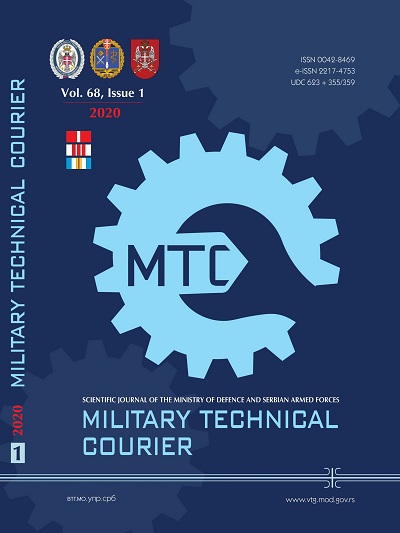Calculating friction force and thermal action of a jet engine jet on the inner surface of a tubular guide
Abstract
Introduction/purpose: To study the dynamics of launchers with sources of high-energy gas jets, it is relevant to calculate shear forces from the action of a high-temperature supersonic jet on the inner surface of a cylindrical channel and the temperature of the channel walls. The aim of this work is to develop a comprehensive method for calculating aerodynamic friction and heating on the inner surface of a tubular guide of a rocket.
Methods/results: The research method is based on the theory of supersonic gas flows in cylindrical channels and the theory of the boundary layer. The gas jet is considered continuous, stationary and axisymmetric. The system of differential equations of motion of the projectile in the guide integrates numerically over time. The flow parameters in the pipe sections are found according to the dependences of the theory of supersonic gas flows, taking into account friction losses. To calculate shear stress on the guide wall, we use the relations of the asymptotic theory of the turbulent boundary layer, the theory of turbulent spots of Emmons of the transition boundary layer, and data on the Reynolds numbers of the beginning of the laminar-turbulent transition in wind tunnels. At the same time, the differential equation for heating the thin wall of the guide in the range of contact between the surface of the guide and the jet is numerically integrated. The calculations of the distribution of flow parameters, friction force and the temperature of the wall of the tubular guide during the movement of the projectile inside the jet from the moment the engine is started to the moment the shell exits completely from the guide are performed and graphically presented.
Conclusions: This method of calculating aerodynamic friction and heating on the inner surface of a tubular guide of a rocket due to a high temperature supersonic gas jet - taking into account the effects of nonisothermality, compressibility and laminar-turbulent transition in the boundary layer - can be used to study the dynamics of the launch of rockets from launchers equipped with tubular guides.References
Abramovich, G.N. 1991. Prikladnaja gazovaja dinamika. Moscow: Nauka, Glavnaja redakcija fiziko-matematicheskoj literatury (in Russian). (In the original: Абрамович, Г.Н. 1991. Прикладная газовая динамика. Москва: Наука, Главная редакция физико-математической литературы).
Antunevich, A.L., Il'jov, I.G., Goncharenko, V.P.& Mironov, D.N. 2017. Application of mathematical models for the analysis of complex mechanical system undergoing heterogeneous variable actions. Repository of Belarusian National Technical University, pp.207-213 (in Russian). (In the original: Антуневич, А.Л., Ильёв, И.Г., Гончаренко, В.П., Миронов, Д.Н. 2017. Применение математической модели для анализа сложной механической системы, подверженной неоднородным переменным воздействиям. Репозиторий БНТУ, с.207-213). [online]. Available at: http://rep.bntu.by/handle/data/28261. [Accessed: 21 December 2019].
Bogomolov, A. I. 2003. Osnovanija ustrojstva i raschet reaktivnyh system. Penza: Penza Artillery Engineering Institute (in Russian). (In the original: Богомолов, А.И. 2003. Основания устройства и расчет реактивных систем. Пенза: Пензенский артиллерийский инженерный институт).
Chen, K.K., & Thyson, N.A. 1971. Extension of Emmons' spot theory to flows on blunt bodies. AIAA Journal, 9(5), pp.821-825. Available at: https://doi.org/10.2514/3.6281.
Dziopa, Z., Buda, P., Nyckowski, M., & Pawlikowski, R. 2015. Dynamics of an unguided missiles launcher. Journal of theoretical and applied mechanics, 53(1), pp.69-80. Available at: https://doi.org/10.15632/jtam-pl.53.1.69.
Emmons, H.W. 1951. The Laminar-Turbulent Transition in a Boundary Layer. Part I. Journal of the Aeronautical Sciences, 18(6), p.490. Available at: https://doi.org/10.2514/8.2010.
Kutateladze, S.S. 1979. Osnovy teorii teploobmena. Moscow: Atomizdat (in Russian). (In the original: Кутателадзе, С.С. 1979. Основы теории теплообмена. Москва: Атомиздат).
Kutateladze, S.S. et al. 1985. Teplomassoobmen i trenie v turbulentnom pogranichnom sloe. Moscow: Jenergija (in Russian). (In the original: Кутателадзе, С.С. и др. 1985. Тепломассообмен и трение в турбулентном пограничном слое. Москва: Энергия).
Leontiev, A.I., & Pavlyuchenko, A.M. 2008. Investigation of laminar-turbulent transition in supersonic boundary layers in an axisymmetric aerophysical flight complex and in a model in a wind tunnel in the presence of heat transfer and suction of air. High Temperature, 46(4), pp.542-565. Available at: https://doi.org/10.1134/s0018151x08040159.
Somoiag, P., Moraru, F., Safta, D., & Moldoveanu, C. 2007. A Mathematical Model for the Motion of a Rocket-Launching Device System on a Heavy Vehicle. WSEAS transactions on applied and theoretical mechanics, 4(2), pp.95-101 [online]. Available at: https://www.researchgate.net/publication/261708644. [Accessed: 21 December 2019].
Svetlickij, V.A. 1986. Dinamika starta letatelnyh apparatov. Moscow: Nauka (in Russian). (In the original: Светлицкий, В.А. 1986. Динамика старта летательных аппаратов. Москва: Наука).
Proposed Creative Commons Copyright Notices
Proposed Policy for Military Technical Courier (Journals That Offer Open Access)
Authors who publish with this journal agree to the following terms:
Authors retain copyright and grant the journal right of first publication with the work simultaneously licensed under a Creative Commons Attribution License that allows others to share the work with an acknowledgement of the work's authorship and initial publication in this journal.
- Authors are able to enter into separate, additional contractual arrangements for the non-exclusive distribution of the journal's published version of the work (e.g., post it to an institutional repository or publish it in a book), with an acknowledgement of its initial publication in this journal.
- Authors are permitted and encouraged to post their work online (e.g., in institutional repositories or on their website) prior to and during the submission process, as it can lead to productive exchanges, as well as earlier and greater citation of published work (See The Effect of Open Access).

